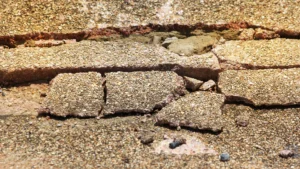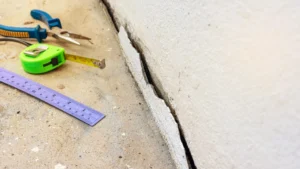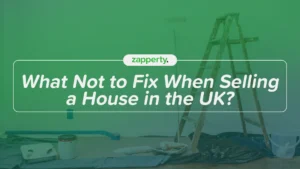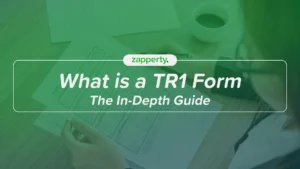Subsidence should not mean the end of your property journey.
It’s the word that strikes fear into any homeowner’s heart. Subsidence. When, quite literally, the foundations of your home become unstable, typically occurs when the ground beneath a building sinks or settles leading to cracks in walls, floors, and ceilings – or worse.
If you suspect your home may be affected by subsidence, it’s important to consult with a structural engineer to assess the situation and recommend appropriate solutions immediately. But what if you are thinking of selling?
You might ask:
Can I sell my house if it has subsidence?
Yes, it is possible to sell a house with subsidence in the UK. However, it will be way more difficult to find a buyer – and you may need to negotiate a lower price. It’s important to be upfront with potential buyers about any subsidence issues and give them any relevant documentation or reports. You’ll find that consulting with a legal professional and a structural engineer will also help you navigate the selling process.
What Causes Subsidence?
Subsidence can be caused by a variety of factors, including issues like past or current mining activities, as well as nearby large trees that can absorb moisture from the ground, causing the soil to shrink and settle. Clay soil can shrink and swell depending on moisture levels, leading to subsidence, and even nearby construction projects can disrupt the ground and cause subsidence.
What signs of subsidence should you look out for?
Cracks. It seems obvious, but if you see cracks in walls, ceilings, and floors – horizontal, vertical, or diagonal – if they seem new or have changed recently.
Sloping floors. Floors should be level. If you notice the floors in your home sloping or they seem increasingly uneven, it’s a danger sign.
Do your doors and windows stick? This is less obvious perhaps – but subsidence can cause doors and windows to become difficult to open or close. So if something gets stuck – or won’t close – it could be a sign.
Mind the gaps. If the foundation has moved, it could show up as gaps between walls and in corners.
Is there sinking or leaning? If your property appears to be sinking or leaning, it could be a sign of subsidence.
What about subsidence insurance – can you make repairs?
Insurance
Most standard home insurance policies include cover for subsidence damage, but there may be exclusions or limitations. If your property has a history of subsidence, you may need to purchase a specialised subsidence insurance policy.
The cost of subsidence insurance varies depending on several factors, including the value of your property, the risk of subsidence in your area, and your insurance provider. It’s essential to compare quotes from different insurers to find the best coverage and price for your needs.
Repairs
You will need to consult with a structural engineer to determine the best course of action for your specific situation. These repairs can include:
Underpinning where the foundation is strengthened usually by installing new support structures beneath the existing ones.
Driving piles into the ground to provide additional support for the building.
Improving the ground through techniques like soil injection or compaction to help stabilise the ground beneath the building.
Five Tips for Selling a House with Subsidence
- Make sure you are transparent. You should disclose the subsidence issue honestly to potential buyers. Hiding information can lead to legal problems and damage your reputation.
- Get professional reports. You should provide buyers with detailed reports from structural engineers and subsidence specialists to demonstrate the extent of the issue and any remedial work completed.
- Make sure you price competitively. You might want to consider a lower price to attract buyers with a discount to offset the potential risks associated with subsidence.
- Don’t forget to highlight the positive. You should emphasise the positive aspects of your property – location, amenities, and condition – to counterbalance the negative impact of subsidence.
- Think about the seller’s market. If the housing market is strong, you may have a better chance of selling your property despite the subsidence issue. However, it’s still important to be transparent and price competitively.
Can you buy a house with subsidence?
If you are thinking of buying a house with subsidence there are some key pros and cons.
Pros:
- There’s lots of potential for negotiation. You may be able to negotiate a lower price due to the subsidence issue.
- Think of the long-term value. Property with subsidence, if properly addressed, can still appreciate in value over time.
Cons:
- Increased risk. Untreated, subsidence can lead to further structural damage and increased maintenance costs.
- Finding a buyer may be challenging, and you may need to offer a significant discount.
- Insurance issues. Obtaining insurance coverage can be difficult and expensive.
Diagnosing Subsidence: How to Know If Your Home is at Risk
Subsidence isn’t always obvious at first. One day, you might notice a small crack in the wall—nothing too concerning. But then it widens. Doors start sticking. Floors feel uneven. Suddenly, you’re questioning whether your home’s foundation is shifting beneath you.
If you suspect subsidence, acting fast is key. The earlier you diagnose it, the easier it is to manage. Here’s a step-by-step guide to identifying subsidence before it becomes a costly nightmare.
Step 1: Look for the Warning Signs
Subsidence isn’t always obvious. It doesn’t start with your house collapsing overnight—it starts with small warning signs. Ignoring them could cost you dearly.
Here’s what to look out for:
- Cracks in walls, ceilings, or floors – Not all cracks mean subsidence, but if they appear suddenly, widen over time, or follow a diagonal pattern near doors and windows, it’s time to investigate.
- Doors and windows sticking – Ever tried closing a door that suddenly won’t shut properly? It could be more than just humidity—subsidence causes frames to shift, making them misaligned.
- Uneven floors – Do your floors feel like they’re sloping? Are your tiles cracking unexpectedly? This could be a red flag.
- Gaps where walls meet ceilings or skirting boards – If your home is moving, gaps will start forming where things were once flush.
- Nearby large trees or drainage issues – If you have big trees sucking moisture from the soil or leaking pipes beneath your property, they could be weakening the ground beneath your home.
Emmy, a homeowner in Leeds, thought the small cracks in her living room were just cosmetic. She ignored them for months. By the time she noticed her front door jamming and a gap forming near her ceiling, a survey revealed serious subsidence caused by leaking drains beneath her home. The repairs? Over £20,000. If she had caught it earlier, she could have avoided major remedial work.
Step 2: Get a Professional Assessment
Spotting the signs is just the first step. To confirm subsidence, you’ll need a professional assessment from a structural engineer or a Royal Institution of Chartered Surveyors (RICS) home buyer’s report.
Here’s what a survey assessment involves:
- CCTV Drain Survey – Hidden leaks? A professional will check underground drainage pipes to see if they’re washing away soil beneath your foundation.
- Expert Structural Engineer Assessment – A trained expert will measure the extent of movement in your home and determine if subsidence is actively occurring.
- Diagnosis Report – This official report outlines the severity of the subsidence and what remedial work (like underpinning) may be needed.
- Completion Certificate Review – If past repairs have been made, they should have official documentation proving that the work was done properly.
If the surveyor suspects subsidence, they may recommend a monitoring period—usually 3 to 12 months—to track any changes before suggesting remedial work.
Why does this matter? If you’re thinking about selling, buyers will want proof that any issues have been professionally assessed. A diagnosis report from a structural engineer can prevent last-minute sales from falling through. Check out why houses struggle to sell here
Step 3: What Happens During the Monitoring Period?
Sometimes, surveyors won’t recommend immediate action. Instead, they’ll monitor the movement of your home to see if it’s an ongoing issue or something that has stabilised.
During this time:
- Surveyors will take precise measurements to track any shifts in your property.
- Monitoring equipment may be installed to detect movement.
- Home insurance providers may require a formal expert assessment before approving coverage or remedial work.
If subsidence continues, repairs like underpinning (strengthening the foundation) may be necessary. But if no further movement is detected, you might avoid costly interventions altogether.
Did you know? If your property has a history of subsidence but has been properly repaired, you can still sell it—sometimes even at full value. Buyers just need reassurance that the issue was diagnosed and addressed correctly. Learn how to add value to your home despite issues like subsidence
What If You’re Trying to Sell a House with Subsidence?
Selling a house with subsidence isn’t easy—but it’s possible. Here’s what you need to do:
- Be upfront and provide documentation – Buyers will run the other way if they feel like you’re hiding something. Having a professional survey assessment and a completion certificate for any past work reassures them.
- Price it right – Homes with subsidence sell for less. But if you factor that into the price, you can still attract the right buyer.
- Consider a quick-sale buyer – Some buyers don’t want the hassle of dealing with subsidence. Zapperty buys homes in any condition, making the process fast and stress-free. Get in touch today for a free, no-obligation offer.
Conclusion: selling your house with subsidence
Selling a house with subsidence can be challenging, but it’s not impossible. By being transparent with potential buyers, providing necessary documentation, and pricing your property competitively, you can increase your chances of finding a buyer. You should consult with professionals like structural engineers and legal experts to navigate the process effectively and minimise risks.
Remember, while subsidence can be a significant issue, it doesn’t necessarily mean your property is unsellable.
If subsidence causes your house sale to fall through, it may not be the end of the world. Cash buyers like Zapperty are keen to buy your house in any condition – including with a diagnosis of subsidence.
So, even with subsidence, with the right approach – or the right buyer – you can still complete the sale.






